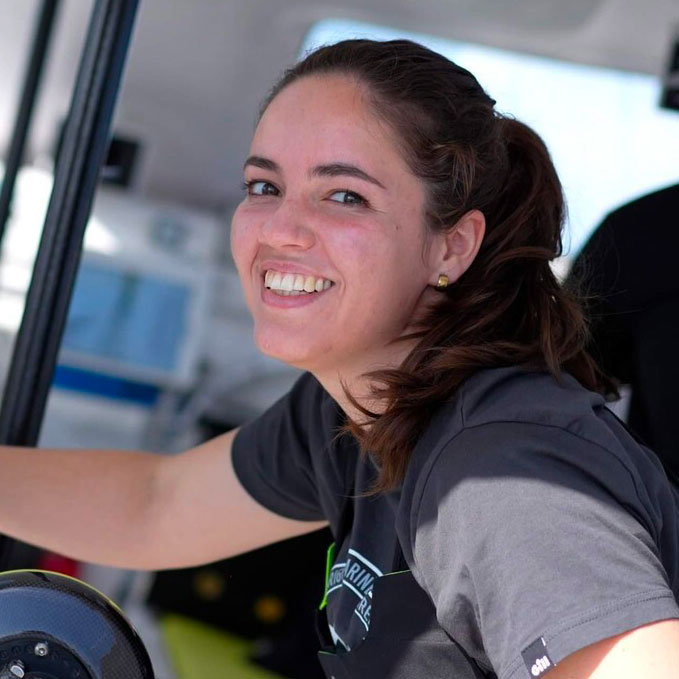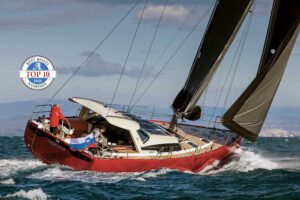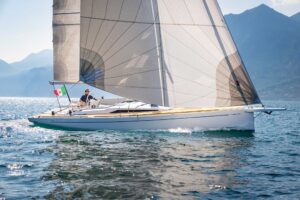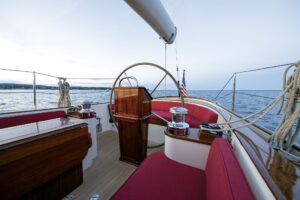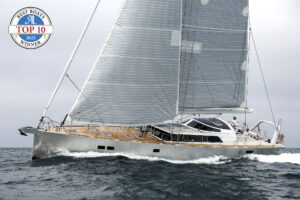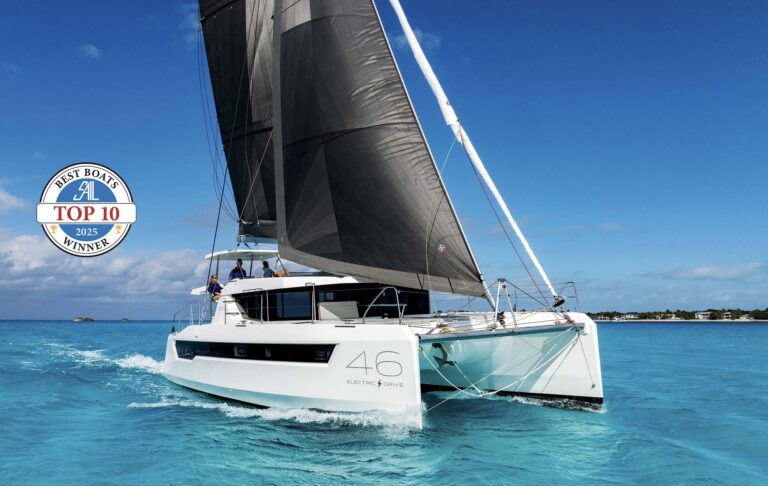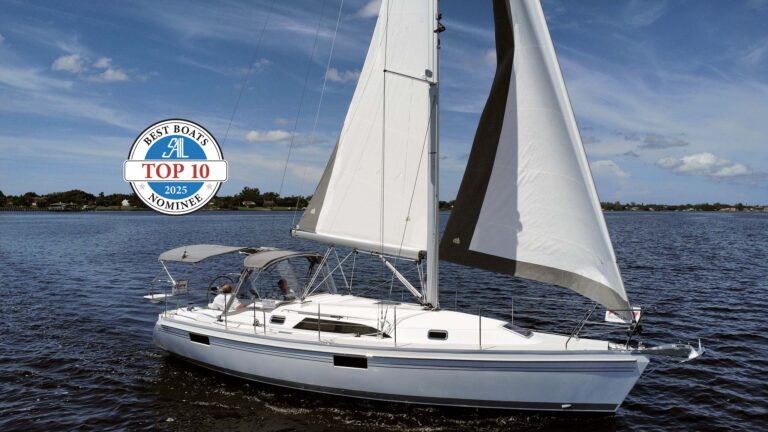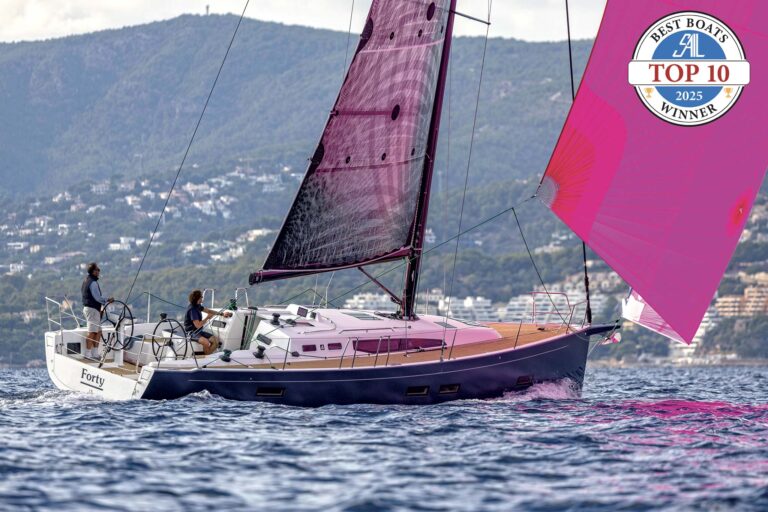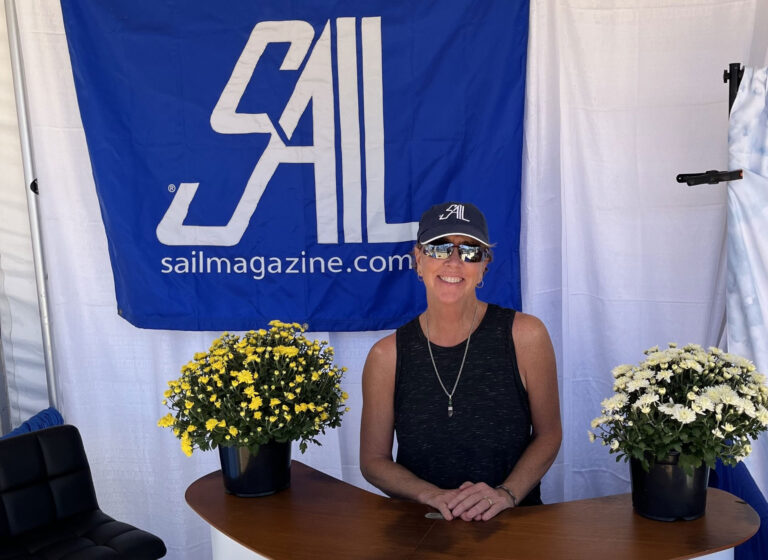Following in the footsteps of the Top 10-winning 510 in 2024 and 460 in 2023, the Hanse 360 has a lot to live up to, and with a clever approach to space onboard, a stable yet speedy hull design, and high build quality throughout, the 360 does not disappoint. Designed by the storied naval architects at Berret-Racoupeau, the 360 is at the smaller end of Hanse’s range at just 36 feet, but this year small boats seem to be the big trend.
Many manufacturers are looking at more accessible, manageable sizes as an essential cornerstone for the future of their brands, and while all of the builders debuting smaller boats this year endeavored to bring big boat features to downsized versions, what Hanse did exceptionally well—and one reason this boat is one of our Top 10 of 2025—was also to embrace the advantages of a small boat, particularly when it comes to boathandling. The designers took full advantage of a lighter boat to improve performance. The result is an ultra-agile, responsive boat that sails brilliantly and still features many of the best innovations from Hanse’s bigger models.
Stepping onto the boat from the stern, there are two steps up to the cockpit to accommodate a lower swim platform for easier boarding. Moving forward, immediately you’ll notice how spacious the cockpit feels for a boat under 40 feet, thanks in part to a 13-foot beam that is carried quite far forward. Soft and hard chines tailor the hull to create more space above while maintaining a svelte profile below the water, enhancing performance and spaciousness.
The sightlines are excellent across the clear, low-profile decks with three incorporated solar panels, one on each side forward of the companionway and one on the foredeck. At a little over 5 feet tall, I had a clean, unobstructed view on both the high and low sides of the boat from the helm.

The dual helms are freestanding, without instrument pedestals. Instead, two Raymarine i70 multifunction displays are mounted just outboard of the helms, directly into angled sections of the deck. The placement provides surprisingly good visibility despite how low down they are. One snag I hit was that the polarization in my sunglasses made the starboard screen hard to read from the most natural place to steer from, but a little step to the side to improve the angle wasn’t an imposition. Like any design update, it just takes some getting used to, and though unconventional, this outboard instrument solution adds more space back into the cockpit, allowing for it to genuinely give the impression of being a bigger boat than it is. A Raymarine Axiom Pro 9 S chartplotter is located at the cockpit table for more in-depth information, and it can be upgraded to a Raymarine Axiom Pro 12 S if desired.
Some of those big boat amenities available in the cockpit include a wet bar, grill, and designated liferaft storage. A centerline table folds down for clear transit all the way around the cockpit and features a built-in fridge for anything you might want easy access to while underway.
Lines on our test boat led to four Lewmar winches (electric 45EST EVOs are an option), partially hidden by integrated rope tracks, which keep the side decks neat and tidy. Most controls are well within reach from the helm, including single-line reefing, so the boat could easily be sailed by two people even if one of them wasn’t particularly handy. If that’s the case, the self-tacker is going to pay dividends, but several headsails are available, including a genoa, gennaker, and crossover. Traditional sheeting tracks are placed up on the cabintop for nice, tight sheeting angles. There’s even an option to add a bowsprit to improve the performance of an asym.
The standard rig reaches 55 feet above the waterline, offering plenty of sail area for a boat of this size (while still fitting comfortably within many waterway bridge requirements, like the ICW). The more ambitious sailor can even opt for a square-topped main and, at the other end of the spectrum, a furling main is also available, making the sailplan truly a choose-your-own-adventure option that will suit many different kinds of sailors.
Toerails that run the length of the boat, high lifelines, and grab points on the cockpit table and side decks make the boat feel secure even on your ear, though you’ll rarely run into issues there because of those aforementioned chines, which minimize excess heeling and keep the boat remarkably stable even in gusty weather.

The hull is made of a quality layered GRP (glassfiber reinforced plastic) construction, with a core mat sandwiched between GRP laminate layers and a vinylester shell. This saves weight and is osmosis resistant.
Belowdecks, semi-custom layouts are available with Hanse’s characteristic multi-zone construction, which lets owners mix and match arrangements for three separate areas below. The forward zone—the owner’s cabin—can be configured with a centerline bed or a diagonal placement to make space for an en suite head to port. The cabin features ample storage in either configuration, including one or two large hanging lockers, depending on if you go with the en suite. Though the owner’s cabin is the one place onboard you will really notice the size difference between the 360 and her bigger sisters, between the generous storage and ample light, it’s in no way a painful sacrifice.
Aft, the salon is also bright and comfortable, with all the usual amenities. To port is three-sided seating around a dining table, and to starboard is a full-length settee, which can be cut short to make space for a small chart table. Just behind that is a well-styled head with plenty of cabinets and a full shower compartment.
The galley is L-shaped and to port with a surprising amount of storage, including a top-down refrigerator with side access plus a second drawer refrigerator. The latter can be swapped out for an additional hanging storage locker, but you might not even need it. That’s because in the third zone, aft of the salon, owners can choose between two guest cabins or one cabin to starboard and a massive storage garage to port. Our test boat had the garage option, and it’s hard to imagine anyone with even a slight ambition for cruising not opting for that. Accessible through the galley or cockpit locker, it is an ideal space for pantry items, spares, fenders…the list goes on.
A variety of handsome color and material options make it possible for the owner get whatever aesthetic they want on the boat, but the double row of windows in the side decks and the 16 opening hatches ensure that it will always be bright and well-ventilated.

Our test sail was on a chilly October afternoon on the Chesapeake just after the Annapolis Sailboat Show. The wind was up and down with sporadic stronger gusts rolling down the Severn River. Sailing 30 degrees true, the wind bounced between 9 and 16 knots, resulting in 5.5 to 6.5 knots of boatspeed. Under full main and jib—which were not being tweaked to wring out racing speeds in the finicky wind—the boat felt zippy and spry, but not to the point of instability.
A majority share of my sailing experience comes from racing dinghies, which means that anything with a keel and a wheel must contend with my base expectations for the maneuverability of a lighter boat and the responsiveness of a tiller. It’s often not a particularly flattering look for big boats. However, whether because of the relatively modest LOA, the smart hull engineering, or the weight—likely a combination of all three—I was very impressed by the 360’s agility. The boat was nimble and peppy, with just the right amount of helm feedback. My expectations were met and exceeded; it was an absolute joy to drive.
Even with the gusts, the boat was never overpowered. After tacking about in clear water for a bit to get a sense of the angles and how the boat moved, I wove us through a mooring field without a single doubt about rounding up into an anchor chain disaster. It took no time at all to feel confident behind the helm of the 360.
Sails down, we did our engine tests. A wide open throttle—3,500 rpm—netted us about 8 knots while a cruising rpm of 2,600 gave us a healthy 7.1.
I’m usually of the school of thought that a boat that tries to do everything does very little of it well, but the Hanse 360 has certainly impressed me with its ability to straddle the line between the comfortable, spacious cruisers that preceded it in Hanse’s line, and the energetic sailing ability of a lighter, more nimble boat. I’m excited to see this kind of careful attention being invested in the smaller side of the market and even more excited with the practical result that Hanse has come up with.

LOA/LWL 37’1” / 33’9’
Beam 13’1”
Draft 5’5” (shallow), 6’ 9” (L-keel medium)
Air Draft 54’11”
Displacement 17,659 lbs (shallow), 17,196 lbs (L-keel medium)
Ballast 3,957 lbs (std), 4,343 lbs (shallow)
Sail Area 656 sq ft (standard main and jib)
Engine 29hp Yanmar
Designer Berret-Racoupeau
Builder HanseYachts, hanseyachts.com
Price $275,400 (base)

January/February 2025

